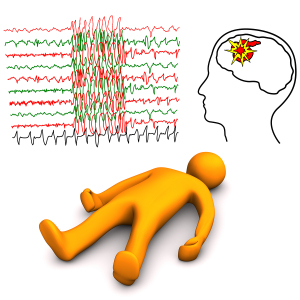Status epilepticus is life threatening, as one seizure after another occurs without a period of normal functioning in between.
The proper full name is:” generalized convulsive status epilepticus”, as outlined in Ref. 5, but most physicians call it status epilepticus.
These authors define status epilepticus as a seizure that lasts 5 minutes or more or as two or more seizures between which patients do not recover.
Treatment
The consensus is that lorazepam (brand name: Ativan, Nu-Loraz), given intravenously and phenytoin (brand name: Dilantin, Diphenylan, Phenytex) are the most effective medications to quickly gain control of status epilepticus.
Other preferred medications are diazepam (brand names: Valium, Zetran, Valrelease), midazolam (brand name: Versed) or propofol ( brand name: Diprivan). Once the status epilepticus has been controlled the patient should be monitored in the Intensive Care Unit with continuous EEG monitoring until stabilized. During this time an intensive work-up needs to be done in the hospital setting to find the cause for this state. If status epilepticus is not treated, many patients would die. Swift action on behalf of onlookers calling 911 for the emergency response team will save many lives.
References:
1. F Zara et al. Am J Hum Gen 2000 May 66(5): 1552-1557.
2. S Yeung et al. Europ J Paediatr Neurol 2000; 4(1): 31-33.
3. LS Leung et al. Neurosci Biobehav Rev 2000 Sep 24(7): 763-775.
4. DJ Yen et al. Epilepsia 2000 Sep 41(9) 1162-1166.
5. E Starreveld et al. Can Fam Physician 2000 Sep 46: 1817-1823.
6. The Merck Manual, 7th edition, by M. H. Beers et al., Whitehouse Station, N.J., 1999. Chapter 172.
7. The Merck Manual, 7th edition, by M. H. Beers et al., Whitehouse Station, N.J., 1999. Chapter 271, p.2415.
8. Ferri: Ferri’s Clinical Advisor: Instant Diagnosis and Treatment, 2004 ed., Copyright © 2004 Mosby, Inc.
9. Rakel: Conn’s Current Therapy 2004, 56th ed., Copyright © 2004 Elsevier







